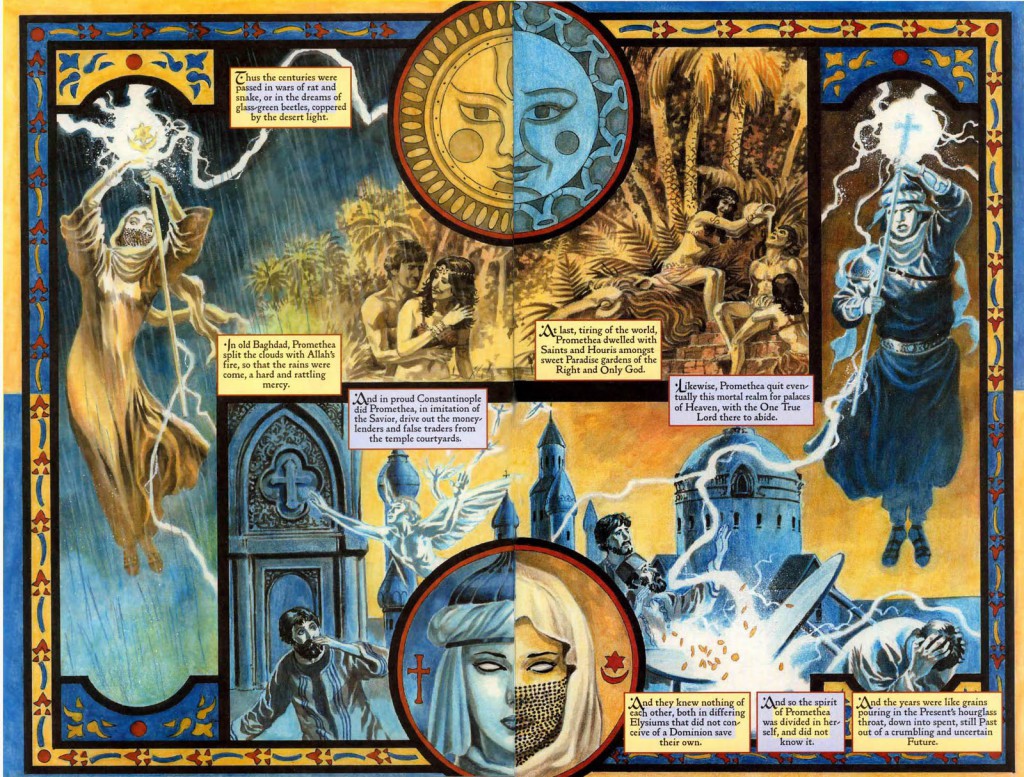Promethea
Written by Alan Moore
Art and Covers by J.H Williams III
Published by America’s Best Comics
To those well-versed in comics, Alan Moore is a legend, a visionary, a god-king. To those passing him on the street, he’s a terrifying, Rasputin-esque vision of haunting eyes, killer tats and a beard so glorious it deserves to go to war and die for queen and country.
Moore’s works populate nearly every list of essential comics reading ever written, him having produced legendary works such as “Watchmen,” “V for Vendetta” and “The Killing Joke.” But it’s a statement to his “Dear God, nothing can stop it!” tenacity that the crazy bugger’s still going. Some would be content with having radically re-defined the comics medium countless times over. Alan Moore simply surveys his work and mulls over what to do next.
Of all his excellent contemporary works, and there are many, few are as fascinating, as mind-shatteringly layered, as monstrously ambitious as “Promethea”.
From the setup, “Promethea” sounds like a fairly standard magic-themed superheroine book. College student Sophie Bangs becomes the latest vessel of Promethea, a living avatar of magic and the written word who has taken human and literary form at various points throughout history. But this is Alan Moore, nothing is ever as simple as it seems.
What “Promethea” really is, more than the superhero comic it wears the skin of, is a kind of graphic novel text book series on, among other things (deep breath) mysticism, tarot symbolism, the qabalistic tree of life, comparative religion, linguistic studies, the role of the written word, magic theory, feminism and a dash of quantum physics (pant pant). In her hero’s journey from college student to cosmic deity, Sophie, and by extension we the audience are given a crash course in all things magical, with enough social commentary and high-minded musings to keep us ever forgetting who’s writing this sucker. It’s essentially like an abbreviated version of Israel Regardie’s The Tree of Life: An Illustrated Study in Magic but with way more pretty pictures and the occasional naked person.
And on the subject of pretty pictures, they don’t get much prettier than this. The artwork comes courtesy of J.H Williams III, one of the most talented artists working in the medium today. Williams’ depictions of forms and ability to convey action are top-notch, but what really sets his work apart are his experiments in panel and page layouts. While the book does start with a standard, if adventurous, layout of square boxes with white borders, as the story goes on and the characters delve deeper and deeper into ethereal realms of higher meaning and significance, the white rectangles are replaced with startlingly beautiful tableau and layouts.
But to return to the writing, “Promethea” is one of those rare comics that sets out to teach you something. In this case, many somethings. Virtually every page is a torrent of information, of unraveled symbolism and links drawn between unexpected sources, like an entire issue devoted to interpreting the tarot as a road map of the creation of the universe and human history, or a sex scene in which the male participant explains the magical significance of various pieces of clothing and brief instruction in Hindu chakras.
“Promethea” is not a book for those just looking for thrills, violence and the occasional bit of cheesecake. Like most of Moore’s work, this is comics as high art, as a conveyer of ideas beyond masculine empowerment and violent catharsis. There are ideas here, people. Big ones. If last week’s recommendation of “Chew” is the gentle nudging of the comics neophyte towards the shallow end of the pool, consider “Promethea” an enthusiastic kick to the hindquarters into the deep end. Time to sink or swim.
– Thomas O’Connor




